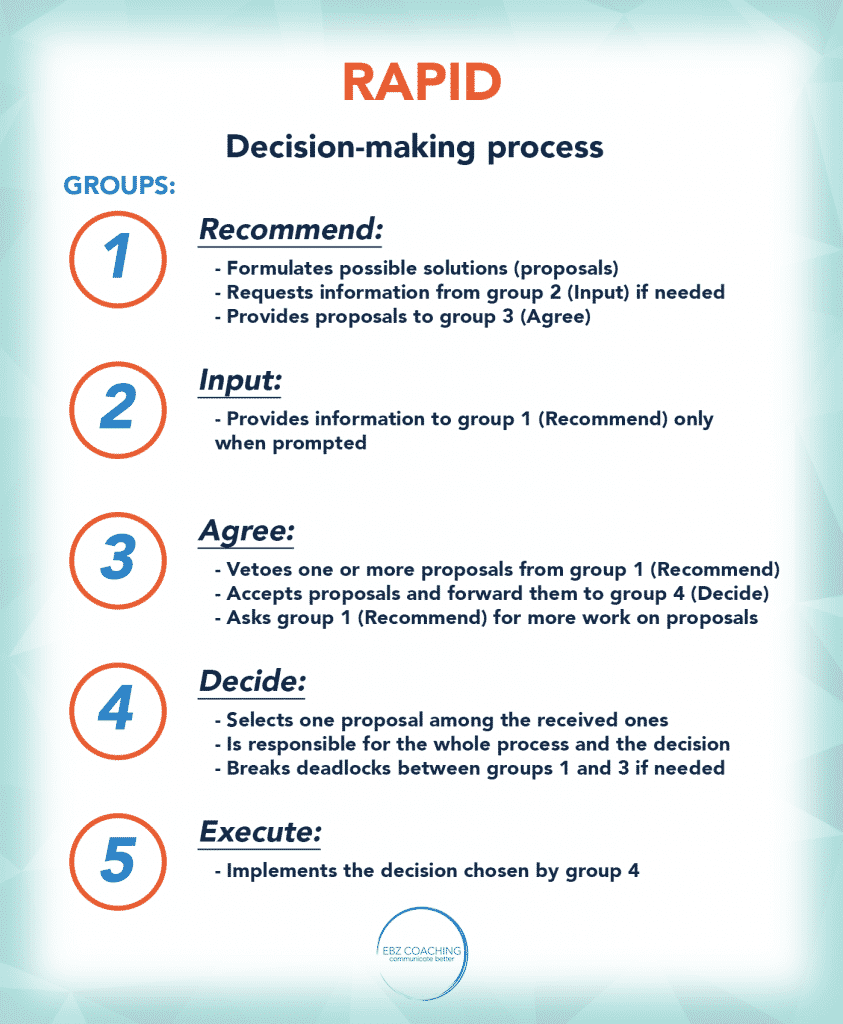Improve your decision making process (5 steps)
Your team’s decision making process should never end in a deadlock. If it does, it’s probably a sign that your team can’t work well together – and that you may need to double down on applying and developing creative leadership.
[podcast_subscribe id=”10042″]
Picture this:
- you need to make a decision, well and fast.
- you bring in your best people to give input and help you out,
- instead of working together to find the best option, they all just bring and defend their own point of view and don’t let go
- you end up stuck in the middle of the decision making process with nowhere to go
- on top, you may be working remotely – which does NOT help when not everyone sees eye-to-eye.
If you’ve been anywhere near this situation, you know how hard it is find a way out, and not surprisingly, the best way to avoid a deadlock, is to not give it any chance in the first place.
Here is how.

The RAPID decision making process
Anytime you need to take a strategic decision for which you can’t afford endless arguments, you need to divide your team in 5 smaller groups, each one with a clear function.
- Group one recommends
- Group two provides input
- Group three agrees
- Group four decides
- Group five executes
Each group can play that one role however they want, but they are not allowed to ever interfere into what another group is doing.
Group tasks
1 – Recommend
Group one, recommend, need to come up with one or more proposals for the decision. To build these proposals they need to gather information, they can do so as they want, and if they think they need a hand, they can involve group two, the ones that provide input.
2 – Input
This group only reacts when prompted. Their job is only to provide what is asked as precisely and as timely as they can to group one, the ones that recommend.
Once group one is done and their proposals are ready, they bring them to group three – the ones that agree.
3 – Agree
Group three looks at the different proposals and can decide to:
- send them back and ask for another iteration;
- veto one or more proposals;
- agree with the options and take them all up to the decision maker, i.e. group four.
4 – Decide
The decision maker will then identify which proposal to go for. In doing so he or she carries the whole responsibility for choosing the right one.
5 – Execute
Once the choice has been made, enter group five, whose only task is to put everything into practice as effectively as possible.
Decision-making process Overview
This is a decision-making process called RAPID, and it’s designed to maximize time efficiency and cut down discussions to a minimum.
As you can see, it leaves complete freedom to each group on how to fulfill their task and completely closes off interference from other areas. This is because you can’t waste time, and you need to allow people maximum focus and independence to do their job well.
To recap the process:
- Group one – recommend – comes up with a few proposals for the decision
- Group two provides input if asked by group one
- Group three – agree – reviews the proposals by group one and can ask for a review, veto one or more, or take them to the decision maker.
- Group four is the decision maker and carries the whole responsibility of the choice
- Group five are the ones in charge of implementing the solution
An extra note: if for any reasons groups one and three (recommend and agree) enter a conflict and end up in a deadlock, it is up to group three – agree – to take it up to the decision-maker, who will then act as a mediator and break the conflict. This is a failsafe device to make sure the process keeps going.
Practical tips
You have all the basics to apply this decision making process in practice, and here are a couple of extra considerations for you.
- First of all: let roles be independent of hierarchy. You can choose to keep the role of decision maker or to assign it to someone else, and you can do the same with all other roles. The only thing that matters is each person’s capability to fit a specific role given the topic – and the roles they play may be different with every decision.
- Second: before you get started, make sure everyone knows the rules well, and don’t allow interference across groups.
- Third: remember that the ultimate responsible is the decision-maker. Make sure that this person is aware of the weight placed upon him or her, and be 100% sure that they can take it.
If you apply this system well, considering these three points above, you can directly count on a more efficient use of your time, on circumventing typical team behaviours in uncertainty, and you’ll be able to cut down on your chances of being paralyzed by a deadlock. You can start with a test on one decision and once your team has worked with it you can even have different decision processes running in parallel. Once it becomes part of your way of working, you’ll be making a consistently better use of everyone’s time, skills and resources, including yours.
Leave a Comment cancel
This site uses Akismet to reduce spam. Learn how your comment data is processed.




Pingback: The 17 highest-impact resources for managers in 2021 - EBZ-Coaching